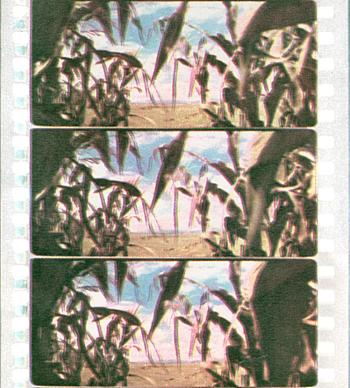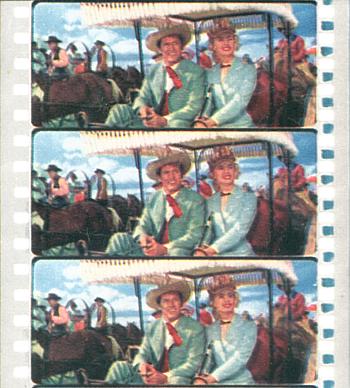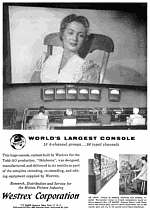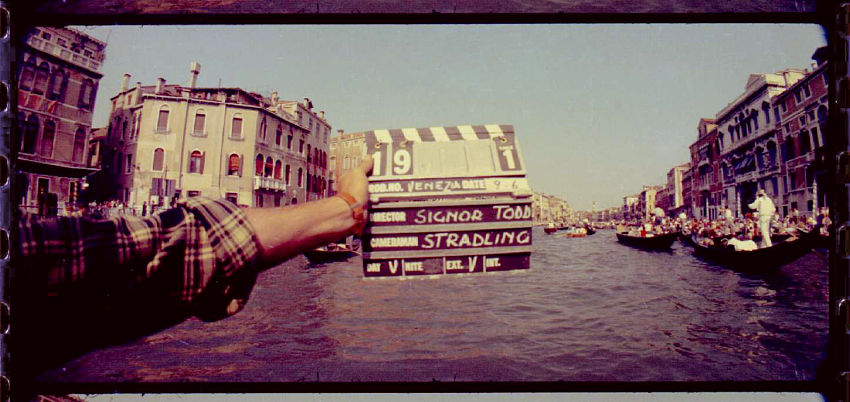|
|
|
|
|
|
|
|
|
|
|
|
70mm Film Finally Makes The Big Time
TODD-AO was conceived as a 65mm system, both for photography and projection. The sound, like Cinerama's was to be reproduced from a 35mm multi-track magnetic film. While details on the interlock sound system have yet to be unearthed, I feel that it is quite likely that it was intended to have at least seven channels, and perhaps more. Using an interlock system for sound reproduction, there was no need for Todd and his crew to settle for fewer channels than Cinerama offered, and it would have been quite easy to offer two more than Cinerama, just as the Soviets did when they copied Cinerama. All during the developmental phase of the system it was 65mm negative, 65mm print, and 35mm interlock sound. It seems apparent that the introduction of CinemaScope, with its magnetic striped prints was the motivation to adopt a 70mm print carrying six tracks. However, a 65mm print and interlock sound was initially seen by the public when "Oklahoma!" premiered at the Rivoli Theatre in New York. How many other theatres ran the roadshow version in 65mm is not known, but it was very few. 70mm prints and Philips/Todd-AO universal projectors were installed in virtually all of the initial theatres.
The Corn Is As Wide As An Elephant's Rump
Film illustrations from the Oklahoma! program booklet showing the width of the 70mm print. In fact the illustrations are taken from a 65mm print. An indication that 65mm prints with 35mm interlocked magnetic film was the original scheme. (That program booklet didn't exactly use state of the art color printing, even for 1955.)
TODD-AO quickly evolved into the familiar 65mm negative and 70mm positive print. With the success of Hazard Reeves' magnetic striping technology which gave CinemaScope its magnetic stripes, Todd-AO added 2.5mm to each side of the film allowing two magnetic tracks to be recorded on the each side of the film outside the sprocket holes and one track on each side was recorded inside the sprocket holes on tracks that laid on top of the edges of the picture. The addition of the magnetic soundtracks reduced the aspect ratio from 2.28: down to 2.2:1
Click this link to see a large version of a ad featuring Todd-AO's sound recording and duplication system.
Another Robert C. Weisgerber donation
A pair of Norelco DP-70 Universal projectors capable of showing 35mm, 65mm, and 70mm films. These machines were installed in the Odeon Theater in Middlesborough (north Yorkshire) England. The Mole-Richardson arc lamps were later changed to Ashcraft.
Photo courtesy of Trevor Wilson.
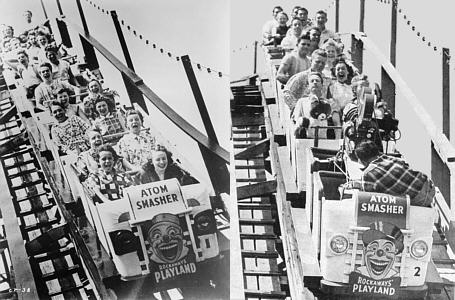
Deja Vu or Et Tu Michael?
Above left, official Cinerama publicity still #CP38, showing the Rockaways Playland "Atom Smasher" roller coaster that introduced the world to wide screen and stereophonic sound. Above right, an early Todd-AO camera with the giant "bugeye" shooting a similar sequence at the exact same park a few years later. This couldn't have been a fun ride for the camera operator. The shot being made may have never been seen by the public. Mike Todd Jr. made both sequences.
Ironic Trivia: The Cinerama sequence was made on coaster #1, using Cinerama camera #1, while the Todd-AO sequence was made on coaster #2, using Todd-AO camera #2. Ironic, but not especially interesting.
Mike Todd Sr. also shot some of the demo to fully demonstrate the "Cinerama out of one hole" concept. He virtually duplicated several of the scenes that had been in This Is Cinerama.
Duplicating the canals of Venice sequence in This Is Cinerama originally photographed by Harry Squire and Mike Todd Jr., cinematographer Harry Stradling and Todd senior traveled through Europe with the bug eye lens shooting a Todd-AO demo to prove it was really "Cinerama out of one hole."
photo courtesy of Thomas HauerslevWhile problems with visible panel lines and color variations exhibited by Cinerama were not a problem with the bug eye lens, it suffered from its own drawback, barrel distortion. Some of this distortion would be removed in projection on a curved screen, but by no means all of it.
















E-mail the author
CLICK HERE
©1996 - 2004 The American WideScreen Museum
http://www.widescreenmuseum.com
Martin Hart, Curator
